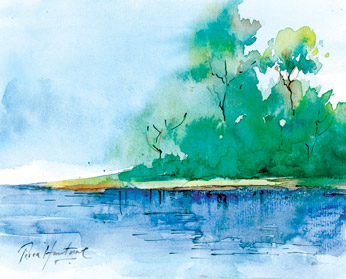|
Learn to draw by Tissa Hewavitarane
Wet and dry techniques in watercolour painting
We have looked at basic watercolour techniques in the past. It is
essential to know and study several techniques to understand transparent
watercolour.
This lesson is an introduction in wet-into-wet and dry brush
techniques. Wet-into-wet is the most spontaneous and exciting technique
in watercolour painting.

It is difficult to use just the technique of painting on a wet
background or just the technique of painting on a dry background in any
given painting. Usually both are used at the same time to achieve the
desired effects of each capturing the exact tones.
The only problem is that these two techniques demand completely
different drying times between application of colours if the base is
wet, the newly applied paint will spread and merge. If the base is
solid, the brush strokes will appear definite and precise.
The wet background
The wet background allows effects of atmosphere, dull shades merging
areas and blending of colours. The extent to which an added colour will
spread depends upon the degree of wetness of the background. Controlling
this enables the painter to work with great confidence in the area where
the colour is being applied.
The wetness is controlled with absorbent paper, with a dry brush or
sponge, or by the natural evaporation of the water. This technique is
ideal for doing such things as cloudy skies, mist billowy trees, a rainy
day.
To start with at first the base should be completely wet with a
sponge or brush. Precaution has to be taken to avoid swelling and
wrinkling of paper. You pin four drawing pins on the four corners of the
board. Some painters tape the paper to the board. Wait for the paper to
dry a little. If you paint while the paper is still soaking wet the
colours will run all over and from the first stage your picture will get
spoilt. Therefore, before you start painting give thought to every
stroke you apply.
Drying time for each coat
To observe the drying time for each coat of paint, continue the same
exercise. In this way you will have a reference paint close at hand
involving the two methods that form this exercise. The work on wet paint
is performed while the paint is drying. Study the painting reproduced
here. It's a simple river scene using three colours: Hookers Green,
Yellow Orchre and Burnt sienna. In doing a wash at times you may have to
use heavy brushes. I have used Nos 8, 3 and 2 for thin lines. The Kent
paper used is 250 grams. |

